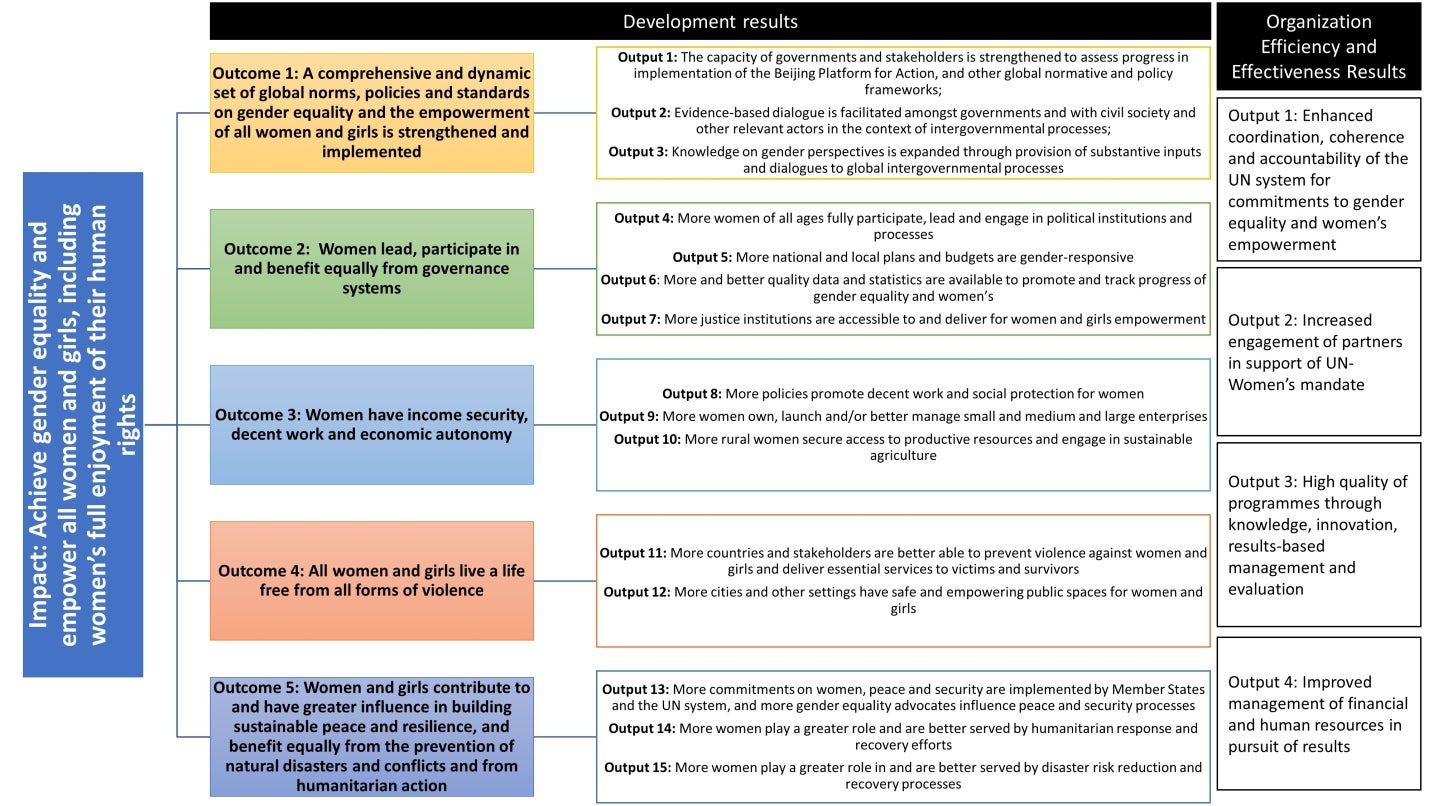UN-Women’s Strategic Plan, 2018-2021
Achieve gender equality and empower all women and girls, including women’s full enjoyment of their human rights
Welcome to the report scorecard of UN-Women’s Strategic Plan, 2018-2021. This website provides you with an overview of results from the implementation of the Strategic Plan, including latest figures and data. The links below allow you to explore UN-Women priorities until 2021 to support the achievement of the Sustainable Development Goals by 2030 and make progress on achieving gender equality and women’s empowerment. For the full report on the implementation of the Strategic Plan in 2021, please click here.
Development Results Outcomes:
- Global norms, policies and standards
- Leadership and governance
- Economic empowerment
- Ending violence against women
- Women, peace and security and humanitarian action
Organizational Effectiveness and efficiency results
UN-Women’s Strategic Plan:

ABOUT THE PORTAL
This portal presents details of development results and organizational performance from 2018 to 2020, the first three years of the 2018-2021 Strategic Plan. Each indicator of the Strategic Plan’s results framework is displayed as a scorecard and data table: the front side shows a graphic representation of performance under 2020 milestones, with subsequent side(s) showing the details of the indicator (baselines, milestones and targets, 2018 and 2021 results). In addition, this portal offers a global overview and highlights of results achieved, expenses by outcomes and regions and resource mobilization.
All indicators, as well as their baselines and targets, are based on the 2018-2021 Strategic Plan’s Integrated Resource and Results Framework (IRRF). For all indicators, baselines refer to data from the year 2017, unless otherwise stated. For all indicators, targets refer to the year 2021, unless otherwise stated. To further refine performance management and strengthen accountability, UN-Women undertook a comprehensive validation exercise to cross-check baselines, milestones and targets in late 2017-early 2018. Based on the results of this exercise, the baselines, milestones and/or targets of 64 indicators were more fully populated / updated in 2018 in an updated version of the IRRF (available here). In 2020, as a result of the mid-term review of the 2018-2021 Strategic Plan, some adjustments to improve the IRRF were proposed. Annex IV: Revised Integrated Results and Resources Framework of UN-Women Strategic Plan 2018-2021 documents these adjustments and is available here. An overview of subsequent COVID-19 revisions, following the completion of a Strategic Reprioritization Exercise, was presented at the August 2020 informal briefing on the Strategic Plan roadmap and update on Integrated Results and Resources Framework adjustment due to COVID-19 (full results framework available here). In January 2021, the IRRF was republished to resolve/provide further information on baselines, milestones and targets that had been listed as "To be confirmed" under 6 indicators in the previous version of the IRRF; the full updated IRRF is available here. In May 2021, the IRRF was republished to resolve baselines and targets under the final indicator where baselines/targets had been listed as "To be confirmed" in the previous version of the IRRF; the full updated IRRF is available here.
For all indicators with available data, progress from baselines to 2021 milestones is noted in this portal using three categories: progress of 90% or more towards the milestones (green), progress of 60% to 89% (amber) and progress less than 60% (red). Where progress is assessment above 150% of milestone/target, the ceiling of 150% is applied. Some of the impact and outcome indicators are derived from the Sustainable Development Goals (SDG) framework.
The methodology applied to indicator measurement is in most cases either cumulative (an accumulation of results so far) or annual (a measure of results within the current year). The accumulation methodology calculates results through a count of the number of cases (generally countries) eligible towards that indicator, including the baseline value, in the current and previous years since the start of the 2018-2021 Strategic Plan. Countries are counted only once throughout the Strategic Plan period, unless stated otherwise. An indicator with an annual measure calculates results through a count of the number of cases reported towards that indicator in the current year only. The sources for measuring each indicator is specified in the IRRF, with the majority being reported directly by UN-Women field presences, through UN-Women’s Results Management System, which provides a comprehensive platform for recording, consolidating, viewing, and analyzing results. For indicators where UN-Women’s Results Management System is the source, a detailed list of countries included in the result on each indicator is included in the footnotes on the relevant page.
Results - Results are changes in a state or condition that derive from a cause-and-effect relationship. There are three types of such changes - outputs, outcomes and impact - that can be set in motion by a development intervention.
Indicator - An indicator is a unit of measurement that specifies what is to be measured along a scale or dimension but does not indicate the direction or change. Performance indicators are a qualitative or quantitative means of measuring an output or outcome, with the intention of gauging the performance of UN-Women against the results it set to achieve.
Baseline - Information gathered at the beginning of a project or programme, in this case UN-Women’s Strategic Plan, against which variations that occur in the project or programme are measured.
Milestone - Specifies a particular value that an indicator should reach by the end of a specific year of the Strategic Plan. It is an “intermediate” target.
Target - Specifies the particular value that an indicator should reach by the end of the Strategic Plan (2021)